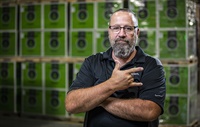
As cannabis grows, transpiration and yield can be maximized using heating, ventilation, air conditioning, and dehumidification (HVACD) equipment to control temperature and humidity. As crops move between different stages of development, ideal environmental conditions for CEA crops may change. Likewise, as cannabis is dried and cured, to speed up the process while preserving terpene and THC content, aroma, and appearance, growers can maintain target conditions using diverse types of HVACD equipment. Attendees of this workshop will come away with an understanding of the basic plant physiology that drives the production of a high-value crop. Understand the best practices for designing, installing, and operating HVAC and dehumidification systems to manage the environment from the plant’s perspective. Learn how to choose efficient products, reduce energy use and operating costs for resilient greenhouses, and maximize incentives from your local utilities and efficiency programs.
Seminar highlights:
Cannabis Science 101: Transpiration and Temperature Response
Selecting Efficient Target Environmental Conditions by Plant Stage
Benefits of High-Performance HVAC and HVAC-D Systems for Greenhouses
Optimizing HVAC System Design
Energy Loads and Equipment Sizing
HVAC Best Practices for Greenhouses
Controls & Automation in Greenhouse Cultivation
Common HVAC mistakes

Add to your calendar with

Rob has over 30 years of experience in plant growth facility management, plant research and commercial production. At Purdue University, he brought online and managed a computer- controlled 40,000 ft 2 research facility, made up of 25 greenhouses and over 60 growth chambers and grow rooms. He was responsible for hundreds of CEA studies involving flowering, food and medicinal species. He served on design teams for greenhouse projects and one of the first automated machine-vision phenotyping centers in the country. In his consulting role, he supported major hydroponic produce growers AeroFarms and Bright Farms; Big Ag companies Dow AgroSciences, Novozymes and Indigo Ag; and several cannabis operations including Clade9. He wrote cultivation plans for cannabis licenses awarded in Missouri and West Virginia.
Rob’s protocols for optimizing greenhouse production have been downloaded over 70,000 times in 104 countries. He participated in the publication, A Practical Guide to Containment: Plant Biosafety in Research Greenhouses, recognized throughout the world as a primary resource for safe production of genetically modified crops. In 2016, he was a member of the International Committee for Controlled Environment Guidelines that published Guidelines for Measuring and Reporting Environmental Parameters for Experiments in Greenhouse Facilities, the seminal document of quality assurance protocols for plant science research.
In his free time, Rob enjoys gardening, growing microgreens under LEDs, baking and winning croquet matches against his three grown children.

Randy Lenz is the Senior Applications Engineer for Anden humidity control solutions including grow-optimized dehumidifiers and humidifiers. He is one of the original founders of Anden and is very passionate about the cannabis industry. Randy has 19 years of experience in controlling humidity for indoor environments, and has a great reputation of providing best-in-class customer service and technical support as well as a thorough understanding of the cannabis space. Randy likes to have one-on-one conversations with cultivators, no matter the day or time, to make sure they are getting the environmental control they need.
